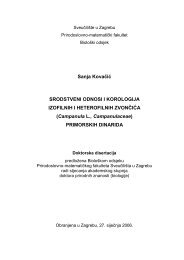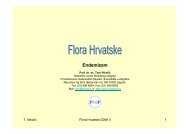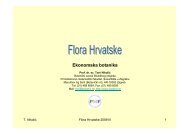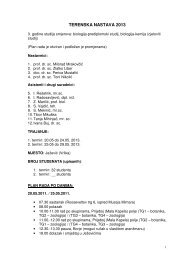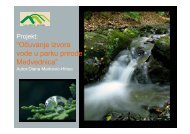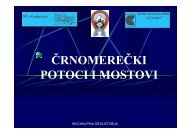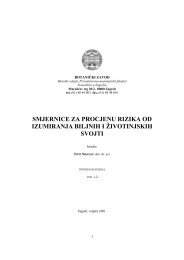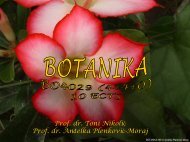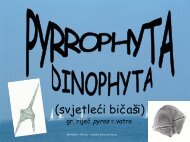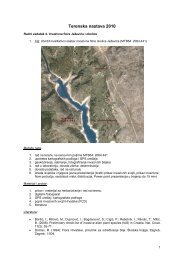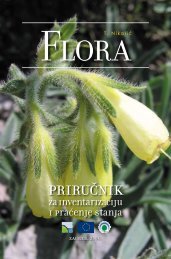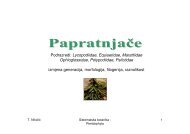important plant areas in central and eastern europe - hirc.botanic.hr ...
important plant areas in central and eastern europe - hirc.botanic.hr ...
important plant areas in central and eastern europe - hirc.botanic.hr ...
You also want an ePaper? Increase the reach of your titles
YUMPU automatically turns print PDFs into web optimized ePapers that Google loves.
Section 1Key statistics on IPA species <strong>and</strong> habitats:Criterion A: t<strong>hr</strong>eatened speciesIn the seven partner countries a total of 518 species qualified under Criterion A, asglobally t<strong>hr</strong>eatened, European t<strong>hr</strong>eatened, or t<strong>hr</strong>eatened national endemics <strong>and</strong> limitedrange species.641 of the 796 IPAs (81%) conta<strong>in</strong> Criterion A species, with a total of 3846 records fort<strong>hr</strong>eatened species at IPAs.98 IPAs (12%) conta<strong>in</strong> Ai, globally t<strong>hr</strong>eatened species548 IPAs (69%) conta<strong>in</strong> Aii, European t<strong>hr</strong>eatened species147 IPAs (18%) conta<strong>in</strong> Aiii, t<strong>hr</strong>eatened national endemic species203 IPAs (26%) conta<strong>in</strong> Aiv, t<strong>hr</strong>eatened near endemic or limited range species149 species have only one site identified <strong>in</strong> any country so far, <strong>and</strong> 328 species have lessthan ten sites identified <strong>in</strong> all of the partner countries.86 IPAs conta<strong>in</strong> t<strong>hr</strong>eatened (Criterion A) bryophyte species, 20 IPAs conta<strong>in</strong> t<strong>hr</strong>eatened(Criterion A) fungi species, <strong>and</strong> 24 IPAs conta<strong>in</strong> t<strong>hr</strong>eatened (Criterion A) lichen species.Criterion B: <strong>botanic</strong>al richness209 IPAs (26%) were assessed for Criterion B, <strong>botanic</strong>al richness.Criterion C: t<strong>hr</strong>eatened habitatsIn the seven partner countries 215 Criterion C habitats from the annexes of theHabitats Directive <strong>and</strong> the Bern Convention were used <strong>in</strong> this project. Priorityt<strong>hr</strong>eatened habitats (Ci) are those def<strong>in</strong>ed as priority <strong>in</strong> the EU Habitats Directive.656 of the 796 IPAs (82%) conta<strong>in</strong> Criterion C t<strong>hr</strong>eatened habitats with a total of 4575records of C habitats at sites.494 IPAs (62%) conta<strong>in</strong> Ci (priority t<strong>hr</strong>eatened habitats)620 IPAs (78%) conta<strong>in</strong> Cii (t<strong>hr</strong>eatened habitats)20 Criterion C habitats have only one site recorded <strong>in</strong> any of the countries, <strong>and</strong> 80Criterion C habitats have less than ten sites recorded <strong>in</strong> all of the partner countries.BRANO MOLNARGeneral habitats at IPAsIn the seven partner countries, forest <strong>and</strong> grassl<strong>and</strong> are the most common habitats atIPAs, occurr<strong>in</strong>g at 68% <strong>and</strong> 65% of IPAs. Mire, bog <strong>and</strong> fen are major components of 31%of IPAs, <strong>and</strong> <strong>in</strong>l<strong>and</strong> water is a significant feature at 30% of IPAs. Heath <strong>and</strong> scrub occur at22% of IPAs, <strong>in</strong>l<strong>and</strong> rocky at 16% of IPAs, coastal habitats occur at 7% of IPAs <strong>and</strong> mar<strong>in</strong>ehabitats at 2% of IPAs. Cultivated <strong>areas</strong> <strong>and</strong> constructed <strong>areas</strong> occur as a small part of31% <strong>and</strong> 22% of IPAs.L<strong>and</strong> use <strong>and</strong> ownership at IPAsAs many of the IPAs occur on exist<strong>in</strong>g protected <strong>areas</strong>, nature conservation <strong>and</strong>research is a major l<strong>and</strong> use at over half of IPAs. Forestry activities occur at 46% of IPAs,animal graz<strong>in</strong>g takes place at 34% of IPAs <strong>and</strong> haymak<strong>in</strong>g for livestock at 14% of IPAs.Agriculture (graz<strong>in</strong>g 34%, arable 14%, mixed 14%) is a significant l<strong>and</strong> use at IPAs.Wild<strong>plant</strong> harvest<strong>in</strong>g also takes place at 13% of IPAs.Almost half of IPAs are owned by state organisations (state 46%, municipal 23 military1%). Many IPAs are also privately owned (private 24%, religious group 1%). In thepartner countries 2% of IPAs are owned by conservation organisations.A third of IPAshave mixed ownership or the ownership is unknown.14



